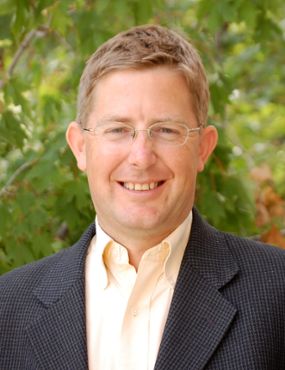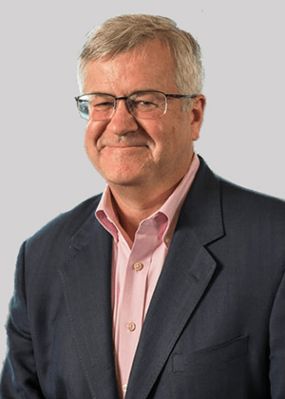Good chemistry: Key hires advance future of science at MSU
Two key Michigan State University hires are paving the way for significant advances in chemistry and related sciences.
Timothy H. Warren joins MSU as the Barnett Rosenberg Professor of Chemistry and chair of the Department of Chemistry in the College of Natural Science (NatSci). Thomas V. O’Halloran comes to the university as an MSU Foundation Professor with joint appointments in the Department of Microbiology and Molecular Genetics (MMG) and the Department of Chemistry.
“We are very fortunate to have not one, but two leaders in metals research—one pioneering new developments in catalysis, the other in understanding metals in biological systems—joining MSU,” said Doug Gage, interim vice president, Research & Innovation at MSU. “Their cutting-edge work aligns well with our Global Impact Initiative thrusts in advanced physical sciences and biomedical research. I’m very excited about the potential synergies created by these two investigators and believe they will have an expansive impact as they work across campus.”

Warren, who officially starts at MSU on June 1, is currently chair of the Department of Chemistry at Georgetown University in Washington, D.C. He has been on the Georgetown faculty since 1999, currently as the Richard D. Vorisek Professor of Chemistry. Warren succeeds Robert J. Maleczka, Jr., who has served as chemistry department chair since 2010.
“MSU is a vast playground for science.” said Warren when asked what drew him to Michigan State. “While chemistry is often called ‘the central science’, to best impact society, all science needs to be viewed through a number of different lenses – and so many are available to look through at MSU.”
“Within the chemistry department,” Warren continued, “we have a broad range of deep expertise. There is a spirit of collaboration within chemistry that extends throughout NatSci and across MSU. I’m very grateful and excited to join these scientific families.”
Warren’s research group, which is re-locating to MSU this summer, embraces sustainability. The team develops environmentally friendly new methods for organic synthesis, explores the interconversion of nitrogen and ammonia as carbon-free fuels, and decodes ways that biology communicates using nitric oxide as a molecular messenger. Specifically, they examine how chemical reactions work catalyzed by earth abundant metal ions such as iron and copper to better enable the development of useful catalysts for synthesis and energy applications as well as to lay the groundwork for therapeutic interventions connected with nitric oxide misregulation. His work is funded by the National Science Foundation, the Department of Energy, and the National Institute of General Medicine Sciences.
“By carefully examining how molecules interact with metal ions in catalysts, new reactivity principles can emerge,” Warren said. “For instance, ammonia is produced on a massive global scale, commonly applied as a fertilizer, especially across farmlands in the Midwest. Recognizing that it is actually a very energy-rich substance, we join MSU chemists Tom Hamman and Mitch Smith who are developing new catalysts to unleash its promise as a carbon-free fuel.”

O’Halloran, who joined MSU in January, was most previously the Charles E. and Emma H. Morrison Professor in the Department of Chemistry and the Department of Molecular Biosciences at Northwestern University in Evanston, Ill. He is also the founding director of the Chemistry of Life Processes Institute and served as director for the Center for Developmental Therapeutics, the Quantitative Bioelement Imaging Center, and the National Cancer Institute/Northwestern University Physical Science Oncology Center. He has been on the Northwestern faculty since 1986.
O’Halloran, an inventor on a number of patents, is the cofounder of several biotech companies. His work has been funded by the National Institutes of Health, the National Science Foundation, the National Cancer Institute, the National Institute of General Medicine Sciences, the Keck Foundation, the Department of Defense, and the ALS Association.
“Over the years, I have worked with many friends in the inorganic and biophysical subdivisions of the MSU chemistry department, as well as the outstanding bioinorganic scholars in the MSU Department of Biochemistry and Molecular Biology and the Department of Microbiology and Molecular Genetics,” O’Halloran said. “I have been deeply impressed by their leadership and international reputation and looking am looking forward to working with them and my new colleagues in the College of Natural Science."
O’Halloran will conduct high-risk, high-reward research into many facets of inorganic physiology, including investigation of how zinc plays a role in controlling fertility as well as investigation of new inorganic compounds that could lead to a treatment for certain types of blood, breast, and brain cancers. Other parts of his research team focus on metals – such as iron, copper, and manganese – that are essential for human development and health. O’Halloran and his collaborators have uncovered the structure function and mechanisms of several classes of metal receptors, including the metallochaperone and metalloregulatory proteins, which control how metals are sensed and managed by cells.
At MSU, O’Halloran will launch and direct a new Elemental Health Institute (EHI), bringing together chemists, microbiologists, physicists, radiologists, veterinarians, plant biologists, and physician scientists from throughout the university as he develops ultrasensitive methods to understand how the chemistry of essential and toxic elements impacts human, animal, and plant health.
“The emerging and dynamic field of metallomics is poised to make major contributions to fundamental research across many areas of biology, such as embryonic development, biomarkers, evolution, plant physiology, neurobiology, host-pathogen interactions, cell state transitions, metabolism, and environmental toxicities,” O’Halloran said. “The goal is to build a national consortium for elemental health research by becoming a locus for technology development and partnerships.”
“I am also delighted to be a part of chemistry's next phase of growth as Tim Warren takes the helm, and to dive more deeply into the interfaces of inorganic chemistry with microbial, plant and mammalian biology in MMG,” he added.
“These two hires are a big boost for chemistry,” said NatSci Dean Phil Duxbury. “In addition to these crucial hires, we will be investing in seven tenure stream faculty positions over the next few years. All of this is being built on a strong, established chemistry effort—both in teaching and in research—and we’re looking forward to building on the outstanding work that the chemistry department is already doing.”
When asked about joining the chemistry department and the serendipity of both he and Tom O’Halloran arriving at MSU at the same time, Warren said that he couldn’t have come to MSU at a better time.
“Approaches to health and disease often focus on interactions between carbon-based molecules,” Warren said. “Tom has been extraordinarily successful at envisioning a larger periodic table of life, elegantly illustrating how metals play key roles in biology and in human development. Through the new Elemental Health Institute, he will bring together a wide range of scientists across campus, uncovering how essential and toxic elements impact human, animal, and plant health.”
“I’m going to build on some incredible expertise already in place at MSU,” O’Halloran said. “All my life I’ve liked working in teams – loud, rambunctious teams; I like applying this teamwork approach to training young scientists and learning how their fundamental research insights could have implications for society. Given the depth and breadth of the scholars across MSU, it has been easy to start a number of new collaborative studies. Every day I see something new, and it’s thrilling.”
“From creative, sustainable ways to manipulate the traditional elements of life, to more fully examining elements in health and disease, to chemically exploring the far reaches of the periodic table and exotic isotopes produced by FRIB,” Warren said, “it is exciting to see this diversity of elements coming together in one place – all bound by the extraordinary human element at MSU.”
Banner image: Bioinorganic chemistry research in the O’Halloran and Warren labs outlines roles metals play in health, disease and the environment, connecting the structure around metals in proteins to valuable molecular level details crucial for their function. Credit: Shiyu Zhang and Subrata Kundu; this graphic appeared on the Nature Chemistry website related to the article Nature Chem. 2016, 8, 663-669.